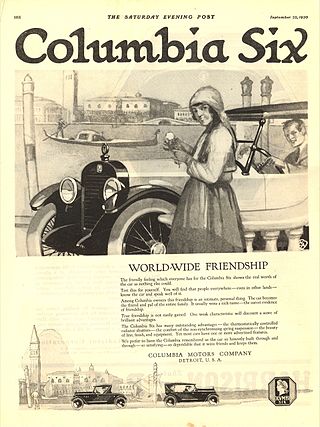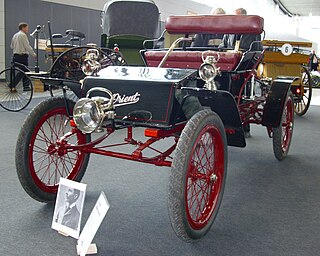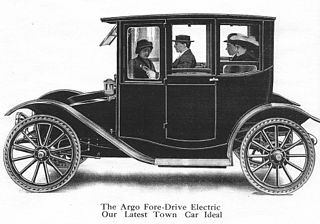
Columbia Motors was a Detroit, Michigan, United States based automobile manufacturer that produced automobiles from 1916 to 1924.

The Brass Era is an American term for the early period of automotive manufacturing, named for the prominent brass fittings used during this time for such features as lights and radiators. It is generally considered to encompass 1896 through 1915, a time when cars were often referred to as horseless carriages.

Alldays & Onions was an English engineering business and an early automobile manufacturer based at Great Western Works and Matchless Works, Small Heath, Birmingham. It manufactured cars from 1898 to 1918. The cars were sold under the Alldays & Onions name. Alldays also built an early British built tractor, the Alldays General Purpose Tractor. After the First World War the cars were sold under the name Enfield Alldays. Car production seems to have ceased in the 1920s but the manufacture of many other items continued. The company became part of the Mitchell Cotts Group.

A cyclecar was a type of small, lightweight and inexpensive motorized car manufactured in Europe and the United States between 1910 and the early 1920s. The purpose of cyclecars was to fill a gap in the market between the motorcycle and the car. A key characteristic was that it could accommodate only two passengers sitting in tandem.

The Stutz Motor Car Company was an American producer of high-end sports and luxury cars based in Indianapolis, Indiana. Production began in 1911 and ended in 1935.

Waltham Manufacturing Company (WMC) was a manufacturer of bicycles, motorcycles, motorized tricycles and quadricycles, buckboards, and automobiles in Waltham, Massachusetts. It sold products under the brand names Orient, Waltham, and Waltham-Orient. The company was founded in 1893, moving to self-propelled vehicles after 1898.

Woods Motor Vehicle Company was an American manufacturer of electric automobiles in Chicago, Illinois, between 1899 and 1916. In 1915 they produced the Dual Power with both electric and internal combustion engines which continued until 1918.

The Austin 7 is an economy car that was produced from 1923 until 1939 in the United Kingdom by Austin. It was nicknamed the "Baby Austin" and was at that time one of the most popular cars produced for the British market and sold well abroad. Its effect on the British market was similar to that of the Model T Ford in the US, replacing most other British economy cars and cyclecars of the early 1920s. It was also licensed and copied by companies all over the world. The first BMW car, the BMW Dixi, was a licensed Austin 7. In France they were made and sold as Rosengarts, and in the United States they were built by the American Austin Car Company. In Japan, Nissan also used the 7 design as the basis for their first cars, although not under licence. This eventually led to a 1952 agreement for Nissan to build and sell Austins in Japan under the Austin name.

The Premier Motor Manufacturing Company built the brass era and vintage Premier luxury automobile in Indianapolis, Indiana, from 1903 to 1925.
The Janoir was a French motorcycle manufactured from 1919 until 1922 in Saint-Ouen. The few that were made were 965 cc flat twins.

The Argo Electric Vehicle Company was an electric automobile manufacturer that operated in Saginaw, Michigan, United States, from 1912 to 1916. The Argo Electric used a 60 volt system with Westinghouse motors. They claimed to be capable of 20 mph (32 km/h). It had 6 forward and 6 reverse speeds, had 36 x 4 cushion tires and used an 18-inch (457 mm) steering wheel on the left. They were offered in both four- and five-passenger models, with open and closed versions available, and all models used steering wheels. The 110-inch (2,794 mm) wheelbase was the longest of any electric at the time. The Argo Brougham was a 4-passenger car, weighing 3,200 lb (1,451 kg), claimed a range of 75 miles (121 km) per charge using thirty 190 ah, MV Exide batteries.

The Hackett was an automobile built in Jackson, Michigan, United States, by the Hackett Motor Car Company from 1916 to 1919.

Scripps-Booth was a United States automobile marque based in Detroit, Michigan. Established by James Scripps Booth in 1913, Scripps-Booth Company produced motor vehicles and was later acquired by General Motors, becoming a division of it, until the brand was discontinued in 1923.

The Partin Manufacturing Company was a brass era American automobile manufacturer, headquartered at 29 South LaSalle Street, Chicago, Illinois from 1913 to 1917. The Partin-Palmer automobile and Pioneer cyclecar were produced.

The W. H. Kiblinger Company and the W. H. McIntyre Company produced Brass Era automobiles in Auburn, Indiana from 1907 to 1915.
This is a chronological index for the start year for motor vehicle brands. For manufacturers that went on to produce many models, it represents the start date of the whole brand; for the others, it usually represents the date of appearance of the main model that was produced.

The Standard Electric automobile was an electric car manufactured by the Standard Electric Car Company in Jackson, Michigan from 1912 to 1915.
The States was a cyclecar manufactured by the States Cyclecar Company of Detroit, Michigan in 1915.

The Clydesdale Motor Truck Company was a motor company that existed from 1917 to 1939 with headquarters in Clyde, Ohio. Initially, they made military trucks for World War I. Military contracts continued to be a large part of their business after the war, but they also sold into many other markets: general haulage, farming, and specialized vehicles such as fire trucks. They survived the Wall Street Crash of 1929 and the Great Depression, but increasingly struggling, they were wound up in 1939.
















